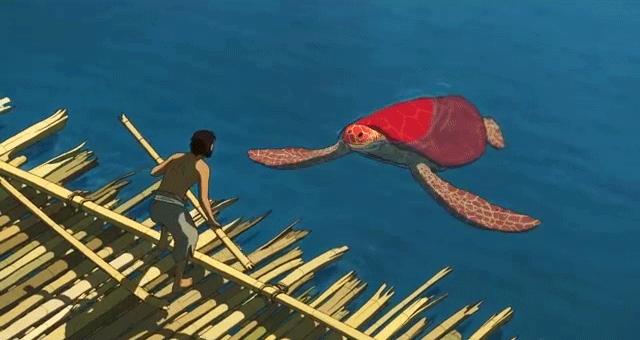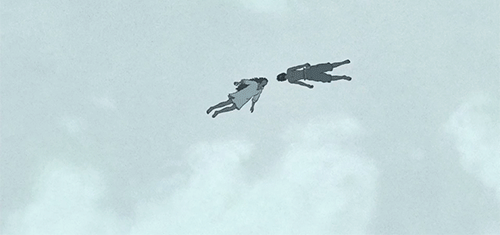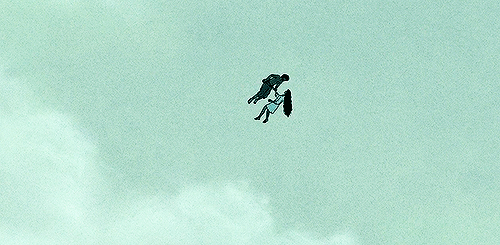レッドタートル Red Turtle
All Turtles Should be Red:
Watching An Isolated Isolation in Reddo Tātoru: Aru Shima no Monogatari レッドタートル ある島の物語
__
In 2016 Japanese director/producer Toshio Suzuki and Dutch animator Michaël Dudok de Wit collaborated to produce a jewel of a silent film; the title translates directly into English as Red Turtle: The story of an island. A film that features a narrative of a shipwrecked existence terrorised by a strangely coloured turtle. The Silence of this film lends and supports its Japanese flavour and taste. One loves the way it is animated with such care and compassion for the re-depiction of reality that it presents. Indeed the narrative of isolation that the protagonist suffers is also a potential re-depiction of reality in that although we are strongly grounded in living in communities of infinite variability this might not provide enough data for an individual to understand their own being. Thus after watching this film we could choose to take away from the experience a question: how do we understand ‘isolation’ as it is in the film and in wider contexts of life?
For me the medium of animation is partly isolating and this needs no proving it is self evident that even with contemporary production software that makes use of nodes and modes so as to maximise and streamline the working of animation the process remains time consuming and therein isolating. But animation is like an island a very small patch of land surrounded by a liquid and in this sense it carries a metaphorical energy that reminds of the place of the cell in artificial movement. But, here the cell seems closer to biology and therefore the belief that one might know a given state of the natural world; although is this not contrary to the truth of animation and its relation to that ancient belief; that ancient truth that states everything is subject to a force understood and experienced as change. Along with this, the relation we have had with knowledge is increasingly troubling me: for instance in the perspective ordered by science we use the word ‘isolation’ in tandem with a positive idea that of objective certainty, ‘we need to isolate the cause’, but at the same time thinking about the social use of the word we find a mainly negative usage of isolating.
There are ways in which individualism which is perhaps the term we might use to describe the idea that isolation is a positive. But, isn’t this cultist self so absurdly false and artificial that it deserves to be laughed at and derided because although there are great achievements made by remarkable individuals is it not the case that these are still socially determined and culturally by acts of barbarism? Is it not a point to wrestle with this antagonism between being all alone, and how in society this is often a kind of punishment: a naughty step, a sin bin, and a detention. Today, though we need to encourage retention so in this spirit one wishes to explore the theme of isolation not as a punishment ( we can do this another day) but rather as a part of survival itself. This will be attempted by way of a short exploration of the wider use of shipwrecked individuals and their islands both in art and wider cultural events. But, before we take a leap from the island with the red turtle let us make a brief nap on the island called language. In Japanese the name for island is Shima, the kanji 島 is composed of two parts bird and mountain and so from a Japanese perspective the position from which we are looking at the island and its isolation is one from the fluid movements of the sea.
Not all islands are in possession of mountains but they all possess their own geological culture which is not dependent on humans being marooned on its land. I wonder if this was a concern at any point for artist Charles Avery created a fictional island under the project The Islanders () one reads that our access to this island is mainly by a town brilliantly named Onomatopoeia and in the manner which these inhabitants might like or appreciate I can not help but take the noun of this capital topos and play on the place called island. Island sounds like its meant to be split into ‘is-land’ and I do not know are ‘is-lands’ the smallest land; is there not some land smaller than an ‘is-land’? I think so however I do not know so! Avery’s project is extremely seductive I want to read more about it and look at his dynamic drawings which are our only points of entry to this fiction that serves as a gateway towards greater insight on the determination that comes hand in hand with isolation. Do Avery’s islanders feel isolated and if so do they actually want foreigners visiting?
Japan, we are told by a world history was isolationist certainly not protectionist as it is now. This most Eastern of islands has a history of not only being isolated but of isolated individuals its almost as if the presence of many separated land masses presented an opportunity for the Japanese to exercise their imagination in spectacular ways. Japan has an island exclusively for Cats, and an island unfortunately patriarchal in its spiritual value (the island of Okinoshima excludes woman). A man named Masafumi Nagasaki has lived as a hermit in Japan for so many years and does not seem to have cared about his isolated condition. Next to this is the specifically unique Japanese notion of being a hermit 引き籠もりHikikomori a withdrawn world. Japan is a country comprised of a series of Islands that gracefully slide from the east of the earth. There are so many beautiful places in this country from the outskirts of Hokkaido, Hiroshima, and Okinawa, to Kyoto and the towering Tokyo.
Next to these Japanese is-lands there is a widely read and influential Arabic story about a boy growing up on a desert Island. I was introduced to this story by the princely German Idealist Friedrich Wilhelm Joseph Schelling who references it in a text he wrote in praise of Immanuel Kant’s monumental achievement in re-defining the place of the subject in human thinking.[I] Schelling references Philosophus autodidactus in dismissing the causal scepticism of David Hume as Kant so forcefully did. Schelling’s words and sentences liken the causal presupposition the necessity of a portion of our judgements being prior to experience because the experience itself is created by the time and space already present at the moment of judging. This independence of our will is perhaps similar to the universal law of gravity suggests Schelling. So here we have an isolation in philosophy an attempt to give ground to a metaphysics that was then in need of solidifying as an objective science. I wonder if the child on this fictional Arabic island shares traits with the red turtle’s captive?
The child like the man finds a route away from isolation by the application of an innate understanding. We learn that this medieval jewel of philosophical reflection might not have made it through history if its author had not been the protégé of a prince who translated the works of Aristotle into Latin. The most delightful thing about this text and it is a quality shared by the animated film is that although theology is present it is as an undercurrent or something you have to see yourself. Rather then the usual focus on a neoplatonic emanation and a kensosis anchored to the One what you have instead is the number two: two islands, two islanders, two forms. Perhaps there are two ideas that are influential for our viewing of this fantastic film: I was recently watching something that gave me the idea that silence (remembering the animation is silent) is made possible by the failure of language. Next to this is the existence of pure negativity that our positivity has to constantly resist? I often wonder if Japanese notions of nothingness are able to mediate this issue. In our Arabic story of island isolation there are frequent moments where the language plays between this dynamic of universality construed as infinite and the finitude of the individual being.
‘since the notion of imperfection is nothing but a mere Non-existence or what depends upon it? And how can he in anyway partake of Non-existence, who is the Pure Existence, necessarily by his Essence; who gives being to everything that exists, and besides whom their is no existence; but He is the being, He is the perfection, He the plenitude, He the beauty, He the glory, He the power, He the knowledge?
…
As if you take any Body whatsoever in your hand, and then move your hand, the body will without doubt follow the motion of your hand? With such a motion as shall be posterior to it in Nature, tho’ not in Time, because they both began together. So all this World is caused and created by this agent, out of time, Whose command is, when he would have anything done, Be, and it is.’
- Ibn Tufayl [II]
To further Tufayl’s contribution to the animated experience let us deal with the ultimate mischief maker called time. The above quote suggests time and space began together and this is indicative of the thoughts of Kant in his Critique of Pure Reason, ‘Time is nothing other than the form of inner sense, i.e., of the intuition of our self and our inner state. For time cannot be a determination of outer appearances; it belongs neither to a shape or a position, etc.’[III] Evil German philosopher Martin Heidegger found Kant’s definition to be inspiring and states so early on in his philosophical masterpiece, ‘…apriori is the interpretation of genuine historical beings. Travelling through time with their own historicity.’ [IV] This motion then is to be considered as nature; time is our natural state. But to resolve these German notions of time let us turn back to the medieval period and to an Asian master, Dogen Zenji who has a distinctly unique concept of time, a ‘Time Being’ or Uji in Japanese. It seems more befitting to both the marooned man attacked by a turtle and other historical individuals such as Nakahama "John" Manjirō who was one of the first Japanese translators to work with the Americans. As a young man Manjirō-san was indeed marooned and shipwrecked on Torishima Island.
In master Dogen’s essay on Time Being, we see how it might be a complete waste of time to initiate a thinking about isolation. Dogen’s words make it appear as if time is a unifying thing only if one has attained the capacity to see the way. Dogen describes a unified and not an isolated time thus, ‘The way the self arrays itself is the form of the entire world. See each thing in this entire world as a moment of time. Things do not hinder one another, just as moments do not hinder one another. The way-seeking mind arises in this moment. A way-seeking moment arises in this mind. It is the same with practice and with attaining the way. Thus the self setting itself out in array sees itself. This is the understanding that the self is time.’[V]This understanding is present and sharply felt if one finds themselves in extreme isolation when one is forced to consider the limits of being: time remains ever present and mischievous. Natural time then is unforgivably uniform and only appears to change; Dogen’s point is that we should learn to partake in this uniformity lest we fall and victimise the self.
In a way the Western perception of isolation dwells in an unhelpful negativity as described in a recent article by researcher Frank Johnson, he says ‘”[R]eality” resides outside the individual. The accepted orientation is to relate to the world in a direct and a discrete way as an external environment. States of cogitation which center on internal phenomena run the risk of being disparaged as irrational and dangerous.’[VI] Here though what is this natural force experienced as the blood red turtle other than a demand to work with this radical evil, this das radikal Böse, or a pure negativity? Freud gives voice to a potential for two methods to unite to solve unwelcome separations and to move towards surviving them; two methods that reside under the names Psychoanalysis and Zen Buddhism may be different but possess the same aim. Writing in ‘Beyond The Pleasure Principle’ Freud diagnoses this devilish red shelled being, ‘errare humanum est perseverare autem diabolicum (to err is human, to persist is of the devil). If this science of the human psyche and the most refined of Asian spiritual practices were to find themselves being brought closer together then we can continue to isolate what makes isolation always potentially part of the silence of animation.
“A state is called the coldest of all cold monsters. Coldly lieth it also; and this lie creepeth from its mouth: “I, the state, am the people.”
- Nietzsche, Thus Spake Zarathustra
Finally these guardian deities of the lonely spirit brought the war.
You are not to blame. I, of course, am not to blame. Everything is the doing of loneliness.
Loneliness made them carry guns, even made them, with the bait of loneliness, shrug off their mothers and wives
and leave toward where the flags flapped.
Trinket makers, cleaners, clerks, students,
all turning into folk shaken with the wind.
Every and each one, no distinction among them. All taught to die was best.
Petty, timid, good-natured people, their thoughts darkened in the name of the Emperor, went off like brats, delighted, hubbubbing.
But on the home front, we’re nervous,
fearful of an arrow with white feathers,
forcing ourselves to push aside skepticism and anxiety,
we try to spend just this one day, we’re all doomed anyway,
drunk on the sake given out.
Egoism, and the shallowness of love.
Bearing it in silence, women wait for rations,
linking themselves like beggars.
People’s expressions growing sadder day by day,
the fate of the folk of an all-out nation,
I had not seen, since my birth, a loneliness so immediate, so profound.
But I no longer care. To me, such loneliness doesn’t mean anything now.
The loneliness that I, I now truly feel lonely about
is that I can’t feel, around me, any desire, not even of a single person,
holding his ground in the opposite direction of this degradation, trying to find the very roots of loneliness as he walks with the world. That’s it. That’s the only thing.
On 5 May 1945, Boys’ Day
- Mitsuharu-Kaneko, The Song of Loneliness
..............................................................................................................................
I. Friedrich Wilhelm Joseph Schelling. (1994) ‘On the History of Modern Philosophy: Kant, ed. By A. Bowie Cambridge, CUP, 94-106
II. Ibn Tufayl. (1929), The History of Hayy Ibn Yaqzan (Alive, Son of Awake), Translated from the Arabic by Simon Ockley. Westminster Press, London
III. Immanuel Kant. (1998), Critique of Pure Reason, Cambridge University Press, B 50. 163
IV. Martin Heidegger. (1996), Being & Time, State University of New York Suny Press. 11
V. Zen Master Dogen, Moon in a Dewdrop, trans. Dan Welch and Kazuaki Tanahashi https://www.thezensite.com/ZenTeachings/Dogen_Teachings/Uji_Welch.html
VI. Frank Johnson. Psychological Alienation: Isolation and Self-ESTRANGEMENT , Psychoanalytic Review (1963), 62:3 (1975:Fall) p.369
全ての亀は赤い亀を入れなければなりません:レッドタートル有る島の物語で塊然い孤独を見っています。
2016年で日本人の演出家スズキ・トツオとホランド人のアニメーター、デゥドクデウィット・マィークル静粛な映画を作るのでご協力しました。題名は英語に翻訳して「Red Turtle: The story of an island」です。映画のナラティブは難破の存在が変なカラード亀経由して恐怖しました。映画の静粛な事は日本的な嗜好に支持しました。私は映画のアニメ仕方で実をまた描くのために用心と慈悲がとても大好きです。実際には、主人公が苦しむ孤立の物語はまた、我々は強く無限の変動のコミュニティに住んでいるに基づいているが、それは個人が理解するのに十分なデータを提供していないということで現実の潜在的な再描写である。したがって、この映画を見た後、私たちは、経験からの質問を取ることを選択することができます: どのように我々はそれがフィルムで、生活の広い文脈で「分離」を理解するのですか?
私ためにアニメの媒体/ミディアムはちょっと孤立化んですので当世流な作る方がノードとモードを使う事にしてもこの孤独から多い時間を過ごすと自明です。でも、アニメは小さいランドを環海の島をみたいだって、このセンスで比喩表現と不自然な動きの細胞が連想します。しかし、ここに細胞は生物学へもっと近くみたいなので、自然の具合の知識を信じる事で他の昔の信心がアニメの実で諸行無常を反しません。そして、前の文章の事隣に皆さんの知識と関係は私に心配を増加しるので、例えば科学の遠近法でこの単語「イソーレシン」と確実で積極的なアイデアで「原因を隔てれなければなりません」ですけど同じ時間でアイソレイトが消極的で社会的な意味を有ります。
アイソレイトの積極的なアイデアの説明するで個人主義を使えます。でも、このカルト自己はむやみに空々しくてアーティフィシャル居るけど、この自己の業績は社会と蛮行経由して決心するからこの業績ために笑いだしますか。要領は西の国の社会で一人で受刑:やんちゃなステップ、シンビン、拘置の対立関係を取り組みますか。今日、保持をしなければなりませんのでこの孤立は処罰じゃない(他の日出来る)いっそ孤立が生き残る方を探ります。アートと文化の旧事で難破の人のソトーリーに島と早く探索しています。でも、島とレッド亀から跳ねる前に言葉の島で小さい昼寝をします。日本語でアィランドの名前島ですので、漢字が”島”二つの部分有って鳥みたいな、山と日本の遠近法から離島に見る立場は流動的な海からよ。
全ての島は山じゃありませんですけど全ての島が人間の難破を依存しないから地層の文化持ちます。私は画家チャールズ・アブーリさんを同じ考え方と思うという事とこの画家が虚構の島を作って居ます。プロジェクトはザーアイランデズだから、皆さんはこの島の参入するのオノマトペ村へ入れるので市民の順調な好み経由して、僕がこの国都の名詞をこの場所で遊びます。アイランドの音はイズーランドに切れてなるを聞こえます。そして、私は知らないにイズーランドが一番小さいランドですか。他のランドはイズーランドに比べてもっと小ささを有りますか。考えるですけど知らないね!アブーリさんのプロジェクトはとても悩ましいのでもっと読みたいと彼の行動的な絵を見たいです。このドローイングは虚構の門と孤独の決心により一層眼力をくれます。アブーリさんのアイランドの人は孤独を感じるか、もし、感じてからこのアイランドの人は外国人を出入りしたいです。
日本、世界の歴史は孤立主義有ったけど今保護主義ですので皆さんに言いました。一番東の島達は孤立主の歴史有るけど遠隔の人という事も別途な陸岸から日本人の想像力を仕方の機会みたいです。日本は青島愛媛県、そして一つの島は隠岐の島が女性差別過ぎます。男性はナガサキ・マサフミさん、日本で多い年に隠者を居ると住んでいましたので気にしないでした。このユニークで日本的な隠者居るで引き籠りが内向的な世界です。日本は国と一連の島が世界の東側から優雅でずらす。日本でたくさん美しい場所有るので北海道と広島と沖縄と京都も屹然い東京です。
これらの日本の島々の隣には、砂漠の島で育った少年についての広く読まれ影響力のあるアラビア語の物語があります。私はこの物語を、人間の思考における主題の場所を再定義する際のイマヌル・キャントの記念すべき功績を称えて書いたテキストの中でそれを引用している、ドイツの理想主義者フリードリック・ウィルヘルム・ジョーゼフ・スケリングによって紹介されました。[1] シェリングは、カントがデビッド・ヒュームの因果的な懐疑を却下する際にフィローソーフィカズ・オートディダクタズを参考にしました。 シェリングの言葉や文章は、経験そのものが判断の瞬間にすでに存在している時間と空間によって作られているので、因果関係の前提は経験の前に判断の一部が必要であると考えています。私たちの意志のこの独立性はおそらくシェリングを示唆している普遍的な重力の法則に似ています。 ですから、ここで私たちは哲学を孤立させ、形而上学に根拠を与えようとしました。 この架空のアラビア島に住む子供が、アカガメの捕虜と形質を共有しているのでしょうか。
男のような子供は、先天的理解の適用によって孤立から離れた道を見つけます。 著者がアリストテレスの作品をラテン語に翻訳した王子の原始者でなかったならば、この中世の哲学的反射の宝石は歴史を通してそれを成し遂げなかったかもしれないことを私たちは学びます。このテキストについての最も楽しいこと、そしてそれがアニメ映画によって共有されている品質は、神学が存在しているけれどもそれはあなたが自分自身を見なければならないという何か不足しているということです。 そうではなく、ネオプラトニックな発散と、人に固定された尖塔に焦点を当てることは、2つの島、2つの島人、2つの形式です。この素晴らしい映画を見るためには、おそらく2つのアイデアがあります。私は最近、言葉の失敗によって沈黙(アニメーションは沈黙していること)が可能になるという考えを与えてくれるものを見ていました。 これの隣に私達の積極性が絶えず抵抗しなければならない純粋な否定性の存在がありますか。私は、何もないという日本の概念がこの問題を解決することができるのではないかとしばしば思う。 島の孤立についての私達のアラビア語の物語では、言語が無限として解釈されるこの普遍性の動的と個人の存在の間で演じる場面が頻繁にあります。
「不完全さの概念は単なる非存在に他ならないのか、それともそれに依存するの か? そして彼はどうしてもとにかく彼の本質によって、純粋な存在である存在しな いのに参加することができます。誰が存在するすべてのものに存在を与えるのか、 それ以外には存在しないのか。 しかし、彼は存在であり、彼は完全さであり、彼は 寛容さであり、彼は美しさであり、彼は栄光であり、彼は力であり、彼は知識であ るか。
…
あなたがどんな体をあなたの手の中に持っていってそしてあなたの手を動かしたか のように、体は間違いなくあなたの手の動きに従うでしょうか? それらが共に始ま ったので、時間内ではなくて、自然の中でそれの後にあるような動きで。ですか ら、この世界はすべて、このエージェントによって引き起こされ、創造されたので す。」
イブン・タフェール [2]
アニメーション体験へのタフェールの貢献をさらに深めるために、私たちは時間と呼ばれる究極のいたずらメーカーに対処しましょう。上記の引用は時間と空間が一緒に始まったことを示唆しています、そしてこれは彼の純粋な理由の批評におけるカントの考えを示しています、「時間は内なる感覚の形式、すなわち私たちの自己と内なる状態の直感の形に他ならない。しばらくの間、外観の決定はできません。 形や位置などに属さない。ドイツの邪悪な哲学者マーティン・ハイデガーは[III]、カントの定義が感動的であると述べ、彼の哲学的傑作の早い段階で述べています。自分自身の歴史を持って時を経て旅をする[IV]。時間は私たちの自然な状態です。しかし、これらのドイツの時間的概念を解決するために、私たちは中世の時代と、明確にユニークな時間の概念、日本語での「時の存在」またはUji(有時)を持っているアジアのマスター、道元禅師に話を戻しましょう。他の歴史的な人、マンジロウ・”ジョン”ナカハマさんと難破の男性にもっと相応をみたいですので、マンジロウ・”ジョン”ナカハマさんは日本人の翻訳者がまずアメリカ人と働きました。若い人でナカハマさんは鳥島に難破しました。
道元禅師氏のTime Being(有時)に関するエッセイでは、孤立について考えることを開始することがいかに完全な時間の浪費になるかを見ています。 道元の言葉は、時間が道を見る能力を達成した場合にのみ、時間は統一的なものであるかのように見えるようにします。道元は統一された、孤立した時間ではない、と説明しています。この全世界のそれぞれのものを時の瞬間として見てください。瞬間がお互いを妨げないように、物事はお互いを妨げません。道を探す心がこの瞬間に生まれます。この心の中に、道を探す瞬間が生まれます。それは練習でもやり方でも同じです。このように、配列の中に出ている自己はそれ自身を見ます。これは自己が時間であるという理解です。[V] この理解は存在し、存在の限界を考慮せざるをえないときに極端に孤立していると感じると鋭く感じられます。自然な時間はそれから容認できないほど一様で、変化するように思われるだけです。 道元のポイントは、私たちが転倒して自己を犠牲にしないように、この統一性に参加することを学ぶべきだということです。
ある意味では、研究者フランク・ジョンソンによる最近の記事で説明されているように、孤立に対する西洋の認識は有益でない否定性を示しています。「現実は個人の外にあります。 受け入れられている方向づけは、外部環境として直接的かつ個別の方法で世界に関係することです。 内部現象を中心とした共引用の状態は、非合理的で危険だと惑わされる危険があります」。[VI] ここで、この急進的な悪、このdas radikalBöse、または純粋な否定的なものと共に働くという要求以外に、この自然の力はどうしているのですか。フロイトは、歓迎されない分離を解決し、それらを生き残るために動くための2つの方法の可能性を表明します。疎遠’精神分析とZen Buddhism禅という名前の下にある2つの方法は異なるかもしれませんが、同じ目的を持っています。「喜びの原則を超えて」と書くと、フロイトはこの悪魔のような赤い殻を診断します(誤った人間は人間であり、持続するのは悪魔です)。 この人間の精神の科学と最も洗練されたアジアの精神的慣行が互いに近づくことを発見することであるならば、孤立を常に潜在的にアニメーションの沈黙の一部にするものを孤立させ続けることができます。
寂しさの歌 四
国家はすべての冷酷な怪物のうち、もっとも冷酷なものとおもはらる。それは冷やたい顔で欺く。欺瞞は、その口から這い出る。
「我国家は民衆で有る」と
ニーチェ・シアラトウストラはかく語る。
遂にこの寂しい精神のうぶすなたちが、戦争を持ってきたんだ。君たちのせぬじゃない。僕のせめでは勿論ない。みんな寂しさがなせるわざなんだ。
寂しさが銃をかつがせ、寂しさの釣出しにあつて、旗のなびく方へ、母や妻をふりすててまで出発したのだ。かざり職人も、洗濯屋も、手紙たちも、学生も、風にそよぐ民となつて。
誰も彼も、区別はない。死ねばいへと教へられたのだ。ちんぴらで、小心で、好人物な人は、「天皇」の名で、目先まつくらになつて、腕白のやうによろこびさわいで出ていつた。
だが、銃後はびくびくものであすの白羽の箭を怖れ、懐疑と不安をむりにおしのけ、どうせ助からぬ、せめて今日ー日を、ふるまひ酒で酔ってすごさうとする。エゴイズムと、愛情の残さ。黙々として忍び、乞食のやうに、つながつて配給をまつ女たち。
日に日にかなしげになつてゆく人人の表情から国をむけた民族の運命のこれほどさしせまつた、寂しさを僕はまだ、生まれてからみたことはなかったのだ。しかし、もうどうでもいへ。僕にとつて、そんな寂しさなんか、今は何でもない。
僕、僕がいま、ほんたうに寂しがつてぬる寂しさは、この零落の方向とは反対にひとりふみとべまつて、寂しさの根元をがつきとめようとして、世界といつしよに歩いてぬるたった一人の意欲も僕のまはりに感じられない、その事だ、そのことだけなのだ。
昭和(ショウワ時代)二○・五・五
端午の日
1.フリードリック・ウィルヘルム・ジョーゼフ・スケリング(1994年). ‘近代的な歴史: カント’. エッドはボウイ・ア、ケーンブリッジのプレス
2.イブン・タフェール(1928年). ‘ حي بن يقظان’, ‘フィローソーフィカズ・オートディダクタズ’アラビア語から翻訳者はサイモン・オックレ、ウエストミンスタープレス、ロンドン
3.イマヌル・キャント(1998年).’純粋理性批判’ ケーンブリッジ大学のプレス
4.マーティン・ハイデガー(1996年).’生存と時間’政府大学のニューヨークのスニープレス
5.道元禅師(ドウゲン・ゼンジ)(1996年)’露滴の月’ 翻訳者はダン・ウエッチと棚橋・カズアキ
6.ジョンソン・フランク(1693年).’心理的な疎隔:孤立と自己の疎遠’精神分析のレビュー,62:3(秋1975年)


